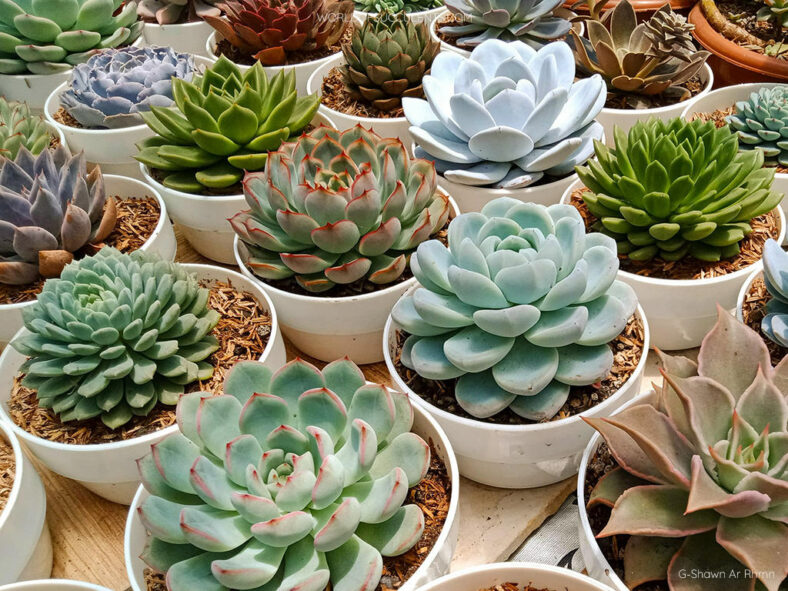Echeveria is a genus of about 150 species of succulent plants in the family Crassulaceae native to the semi-desert regions of Mexico, Central America, and South America. Echeverias have been extensively hybridized, so hundreds of cultivars and hybrids, besides the main species, offer a wide range of colors, sizes, and leaf shapes. They usually produce stunning flowers.
Thanks to their charming rosettes and gorgeous water-storing leaves, Echeverias are among the most popular succulent plants. Some plants can grow to the size of a dinner plate, and their pearlescent tones make them stunning focal points for potted arrangements, rock gardens, favors, decor, and much more. Echeverias are polycarpic, which means they can produce flowers multiple times. Often, numerous offsets are produced. They are commonly known as "Hen and Chicks," which can also refer to Sempervivum, significantly different from Echeveria. In winter, many Echeverias lose their leaves, though not all.
The generic name "Echeveria" honors the 18th-century Mexican botanical artist Atanasio Echeverría y Godoy.

Growing Conditions for Echeveria
Light
Echeverias prefer full sun to partial shade. However, avoid drastic sunlight changes and full afternoon sun, especially in summer. If you move your plants outside in the spring, do it gradually. The intense afternoon sun can cause sunburn. During the winter, when your Echeverias are inside, put them near the brightest window in your home. They will stretch if they do not have enough sunlight.
Soil
These succulents make ideal potted plants but will also thrive in the ground. Echeverias need a potting soil mix that drains quickly. Many growers will create their own mix. However, commercial succulent potting mixes will work fine.
Temperature
Echeverias are tender succulents. Many will tolerate several degrees below freezing but do not grow them in the ground if they are subject to harsh conditions. You can keep Echeverias healthy during the winter by moving them indoors. Once the threat of frost is over, move your plants back outside in the spring. Most Echeverias are cold hardy down to USDA hardiness zone 9a, 20 °F (-6.7 °C).
Pot Size
The ideal pot size for most succulents is 5 to 10 % bigger than the size of the plant at the surface. An Echeveria of around 4 inches (10 cm) in diameter would fit into a pot about 4.5 inches (11 cm) in diameter or just a little bigger than the rosette.
General Care for Echeveria
Watering
When and how to water is a crucial part of Echeveria care. They do not like to be kept too wet, but they also do not like to be kept too dry. Wrinkled leaves indicate the plant needs more water. Provide moderate amounts of water from spring to fall. The "soak and dry" method is the preferred schedule for watering Echeverias. Let the soil dry out before you water again. If you have saucers under the pots, make sure after a short time to empty the water. During winter, water your Echeverias just enough to keep the plants from shriveling.
Fertilizing
Echeverias grow well without fertilizer but may benefit from the extra nutrients. Use a slow-release fertilizer in spring or a liquid fertilizer diluted 2 to 4 times more than usual and used less often than recommended. Remember that it is easier to overfertilize Echeverias than to underfertilize.
Repotting
Repot your plants only as needed during spring or early summer when they are actively growing. To repot an Echeveria, make sure the soil is dry before repotting. Take your plant out of its current pot and remove the old soil from the roots. Place the plant in a new pot with fresh potting soil. Wait at least a week after repotting to water your Echeveria to reduce the risk of root rot.
Pruning
Echeveria is self-pruning. All you may need to do is pick out the dead leaves or flowers. Picking out the dead leaves prevents rot or disease from taking over the plant.
How to Propagate Echeveria
Echeverias are one of the easiest succulents to propagate. They are usually propagated by offsets or leaves, but they can also be grown from stem cuttings and seeds. The best time to separate offsets and take cuttings is in the spring.
Offsets
These succulents often self-propagate through offsets nestled against the mother rosette. They are easy to separate and grow. Just pull the little rosette away and replant it in potting soil.
Leaves
Most Echeverias can be easily grown from leaf cuttings. To propagate a leaf cutting, gently twist the leaf from the stem. Allow the leaf to callus for a few days before placing it in well-draining soil. Always take at least two leaves because not every leaf you try to propagate will grow a new plant.
Stem Cuttings
Another easy way to propagate Echeverias is to take cuttings. However, this is not a common method for plants with rosettes that grow low to the ground.
Seeds
When growing Echeverias from seeds, one of the most important things is the quality of the seeds. The fresher the seeds, the more likely they are to germinate. The best time to sow the seeds is in spring or summer. They usually start to germinate after 2 to 3 weeks. Seedlings can take from 18 months to 3 years to mature.
Pests and Diseases of Echeveria
The biggest issue with Echeverias is overwatering. Mealybugs can also be a problem. Remove dead leaves because they can attract other pests or cause fungal diseases.
Toxicity of Echeveria
Echeverias are safe around pets and humans, although it is not advisable to eat them.
Links
- Back to genus Echeveria
- Succupedia: Browse succulents by Scientific Name, Common Name, Genus, Family, USDA Hardiness Zone, Origin, or cacti by Genus